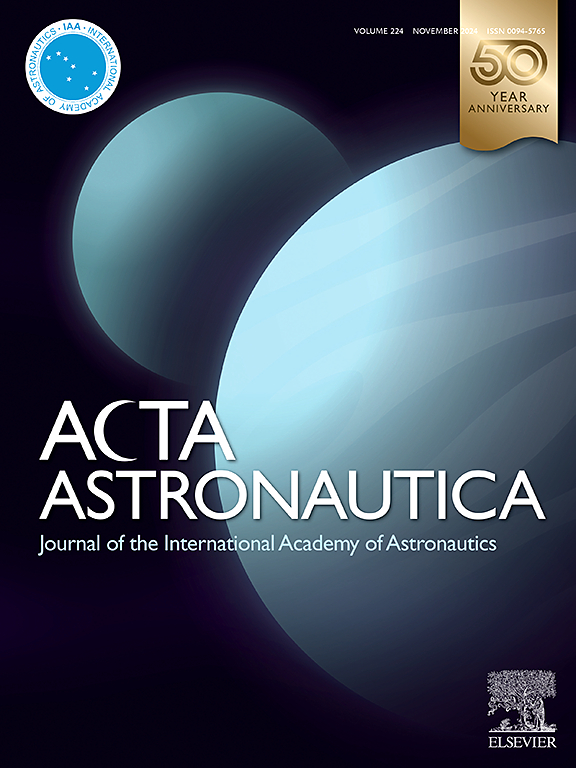Investigation of discharge voltage characteristics of a lanthanum hexaboride heaterless hollow cathode
IF 3.1
2区 物理与天体物理
Q1 ENGINEERING, AEROSPACE
引用次数: 0
Abstract
This study investigated the discharge voltage characteristics of an argon-fed lanthanum hexaboride heaterless hollow cathode to assess the influence of flow rate, discharge current, background pressure, and applied magnetic field strength. Decreasing the flow rate from 15 to 3 sccm led to a considerable increase in discharge voltage and peak-to-peak oscillation, particularly for flow rates below 5 sccm. Subsequently, variation in discharge current was tested at 4–7 A; this test revealed that the discharge voltage decreases from 53 to 48 V as the discharge current increases, while the peak-to-peak oscillation increases by approximately 2 V with the rise in discharge current. At high background pressures (8.1 × 10−4 Torr), the discharge voltage decreased by 15 V, and the peak-to-peak oscillation was maintained at 5 V. Furthermore, the spectral analysis of the discharge voltage indicated the occurrence of high-energy oscillations at 10–500 kHz owing to ionization instability. The discharge voltage decreased when the strength of an externally applied axial magnetic field increased from 0 to 118 G. Such a result can be attributed to increased ionization (caused by the applied magnetic field) in the emitter and cathode-keeper region, thereby decreasing sheath potential on the emitter surface.
六硼化镧无加热器空心阴极放电电压特性的研究
本研究调查了氩气馈电六硼化镧无加热器空心阴极的放电电压特性,以评估流量、放电电流、背景压力和外加磁场强度的影响。将流速从 15 sccm 降低到 3 sccm 会导致放电电压和峰峰振荡显著增加,尤其是流速低于 5 sccm 时。随后,测试了放电电流在 4-7 A 时的变化;测试显示,随着放电电流的增加,放电电压从 53 V 下降到 48 V,而峰峰振荡则随着放电电流的增加而增加约 2 V。在高背景压力(8.1 × 10-4 托)下,放电电压降低了 15 V,峰-峰振荡保持在 5 V。此外,放电电压的频谱分析表明,由于电离不稳定性,在 10-500 kHz 处出现了高能振荡。当外部施加的轴向磁场强度从 0 G 增加到 118 G 时,放电电压降低。这种结果可归因于发射极和阴极保持区的电离增加(由施加的磁场引起),从而降低了发射极表面的鞘势。
本文章由计算机程序翻译,如有差异,请以英文原文为准。
求助全文
约1分钟内获得全文
求助全文
来源期刊

Acta Astronautica
工程技术-工程:宇航
CiteScore
7.20
自引率
22.90%
发文量
599
审稿时长
53 days
期刊介绍:
Acta Astronautica is sponsored by the International Academy of Astronautics. Content is based on original contributions in all fields of basic, engineering, life and social space sciences and of space technology related to:
The peaceful scientific exploration of space,
Its exploitation for human welfare and progress,
Conception, design, development and operation of space-borne and Earth-based systems,
In addition to regular issues, the journal publishes selected proceedings of the annual International Astronautical Congress (IAC), transactions of the IAA and special issues on topics of current interest, such as microgravity, space station technology, geostationary orbits, and space economics. Other subject areas include satellite technology, space transportation and communications, space energy, power and propulsion, astrodynamics, extraterrestrial intelligence and Earth observations.
 求助内容:
求助内容: 应助结果提醒方式:
应助结果提醒方式:


